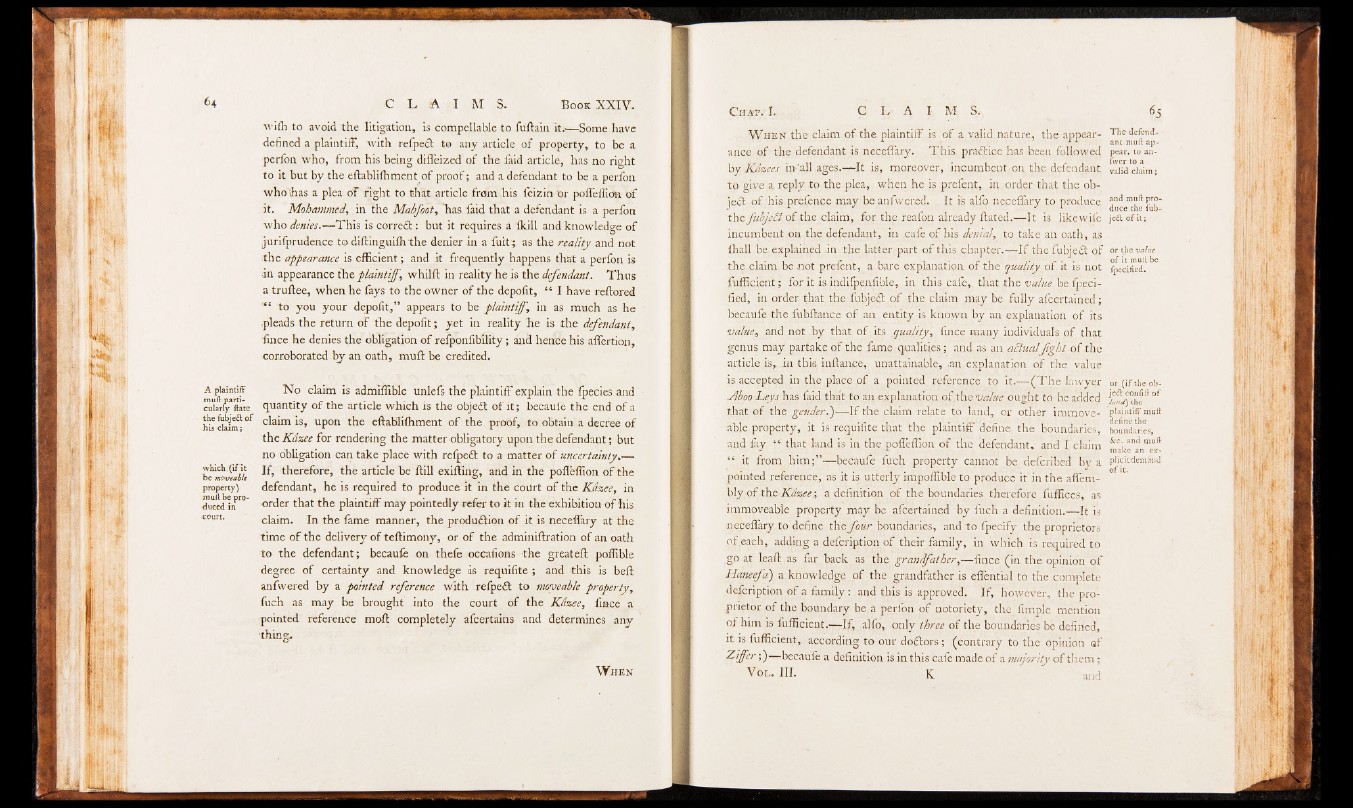
A plaintiff
mu ft particularly
ftate
the fubjeft o f
his claim;
which .(if it
be moveable
property)
mull be produced
in
court.
wifti to avoid the litigation, is compellable to fuftain it.— Some have
defined a plaintiff, with refpeit to any article of property, to be a
perfon who, from his being difleized of the faid article, has no right
to it but by the eftablifhment of proof; and a defendant to be a perfon
who ihas a plea of right to that article from his feizin or pofleffion of
it. Mohammed, in the Mabfoot, lias laid that a defendant is a perfon
who denies.— This is correct: but it requires a fkill and knowledge of
jurifprudence to diftinguifh the denier in a fuit; as the reality and not
the appearance is efficient ; and it frequently happens that a perfon is
an appearance the plaintiff., whilft in reality he is the defendant. Thus
a truflee, when he fays to the owner of the depofit, “ I have reftored
to you your depofit,” appears to be plaintiff, in as much as he
pleads the return of the depofit; yet in reality he is the defendant,
fince he denies the obligation of refponfibility; and hence his aflertion,
corroborated by an oath, muft be credited.
N o claim is admiffible unlefs the plaintiff explain the fpecies and
quantity of the article which is the objeft o f it; becaufe the end of a
claim is, upon the eftablifhment of the proof, to obtain a decree of
the Kdzee for rendering the matter-obligatory upon the defendant; but
no obligation can take place with refpeft to a matter of uncertainty.—
If, therefore, the article be ftill exifting, and in the pofleffion of the
defendant, he is required to produce it in the court of the Kdzee, in
order that the plaintiff may pointedly refer to k in the exhibition of his
claim. In the fame manner, the production of it is neceflary at the
time of the delivery o f teftimony, or of the adminiftration of an oath
to the defendant; becaufe on thefe occafions the greateft poflible
degree of certainty and knowledge ds requifite ; and this is beft
anfwered by a pointed reference with refpedt to moveable property,
fuch as may be brought into the court of the Kdzee, fince a
pointed reference moft completely afcertains and determines any
thing.
W h e n
W hen the claim of the plaintiff is of a valid nature, the appearance
of the defendant is neceflary. This practice has been followed
by Kdzees in'all ages.—It is, moreover, incumbent-on the defendant
to give a reply to the plea, when he is prefent, in order that the object
.of his prefence may be anfwered. It is alfo neceflary to produce
the fubjedl of the claim, for th,e reafon already ftated.—-It is likewife
incumbent on the defendant, in cafe of his denial, to take an oath, as
fhall beexplained in the latter part of this chapter.—-If the fubjeCt of
the claim be .not prefent, a bare explanation of the quality of. it i,s not
fufficient; for it is indifpenfible, in this cafe, that the value be fpeci-
fied, in order that the fubjeCt of the claim may be fully afcertained;
becaufe the fubftance of an entity is known by an explanation of it;s
value, and not by that of its quality, fince many individuals of that
genus may partake of the fame qualities; and as an, aSlualfight of the
article is, in this inftance, unattainable, -an'explanation of the value
is accepted in the place of a pointed reference to it.—(The lawyer
Aboo Leys has faid that to an explanation of thevalue ought to be added
that of the gender.)— If the claim relate to land, or other immoveable
property, it is requifite that the plaintiff define, the boundaries,
and fay “ that land is in the pofleffion of the defendant, and I claim
“ it from him;”—becaufe fuch property cannot be defcribed by a
pointed reference, as it is utterly impoffible to produce it in the aflem-
bly of the Kdzee.; a definition of the boundaries therefore fuffices, as
immoveable property may be afcertained by fuch a definition.—It is
neceflary to define the fou r boundaries, and to fpecify the proprietors
of each, adding a defcription of their family, in whicft is required to
,go at leaft as far back as the grandfather,—fince (in the opinion of
Haneefa) a knowledge of the grandfather is eflential to the complete
defcription of a family: and this is approved. If, however, the proprietor
of the boundary be a perfon of notoriety, the Ample mention
of him is fufficient.—If, alfo, only three of the boundaries be defined,
it is fufficient, according to our dodlors; (contrary to the opinion <sf
Ztffer; )—becaufe a definition is in this cafe made of a majority of them;
Vol. III. K and
The defendant
muft; appear,
to an-
fiver to a
valid claim;
and muft produce
the fub-
je£t o f it;
or the value
o f it muft be
fpecified.
or ( if the- ob-
jeft confift o f
land) the
plaintiff muft
define the
boundaries,
&c. and muft
make an explicit
demand
o f it.